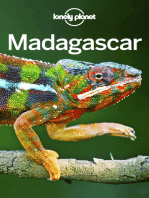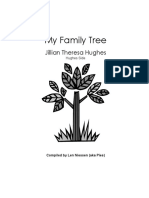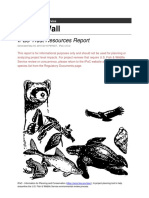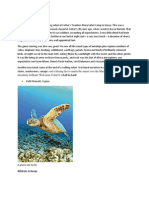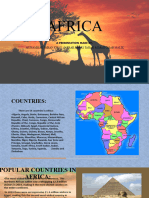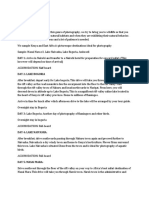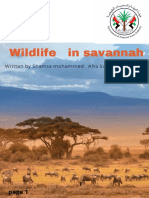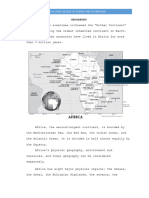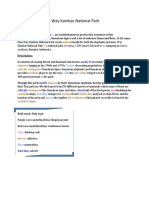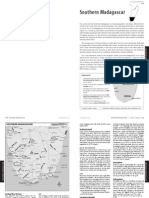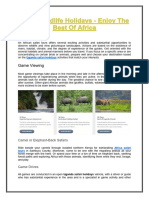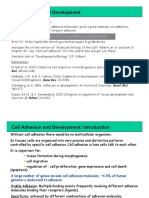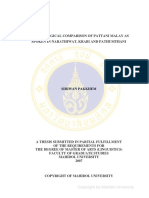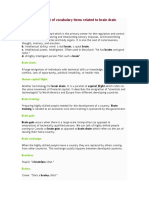Masai Mara
Masai Mara
Uploaded by
Alfin MunfirohCopyright:
Available Formats
Masai Mara
Masai Mara
Uploaded by
Alfin MunfirohOriginal Description:
Original Title
Copyright
Available Formats
Share this document
Did you find this document useful?
Is this content inappropriate?
Copyright:
Available Formats
Masai Mara
Masai Mara
Uploaded by
Alfin MunfirohCopyright:
Available Formats
Maasai Mara National Reserve is in the south west of Kenya.
The Maasai Mara is not a National Park, but rather a National Reserve belonging to the Maasai people and administered by the local county councils. It is one of the best known and most popular reserves in Africa. The Maasai Mara National Reserve is each year visited by thousands of tourists, who come here to watch the many different wildlife and birdlife species in the reserve. The reserve is especially famous for the high amount of predators, such as lions and cheetah, and the 1.5 million wildebeest which migrate through the Mara and cross the crocodile infested Mara river. The best kept secret of the Mara is the Mara Triangle, the North-Western part of the Maasai Mara which is managed by the Mara Conservancy on behalf of Trans-Mara County Council - the rest of the reserve falls under Narok County Council. Although one third of the Mara, The Mara Triangle has only one lodge within its boundaries (compared to the numerous camps and lodges on the Narok side) and has well maintained, all weather roads. The rangers patrol regularly which means that there is almost no poaching and therefore excellent game viewing. There is also strict control over vehicle numbers around animal sightings which means a better, more authentic, experience when out on a game drive. The Maasai Mara is characterized by four different kinds of topography: sandy soil and small bushes to the east, the Siria Escarpment forming a spectacular plateau as the western boundary of the reserve, lush grasslands and woodlands around the Mara River and open plains with scattered bushes making up the largest part of the reserve. The landscape is very varied and has a romantic feeling to it, as can be witnessed in the film 'Out of Africa', which was filmed here in 1985. When visiting the Maasai Mara you are likely to see the famous Big Five: lion, leopard, elephant, rhino and buffalo. Especially lions are common here, and have grown relatively accustomed to their two-legged visitors, which makes them easier to spot. The Mara Plains are teeming with wildebeest, zebra, giraffe, impala and Thomson's gazelle. Also cheetahs, hyenas and jackals are seen regularly in the reserve. In the Mara River large amounts of hippos and crocodiles are enjoying their lives the crocodiles are especially happy in July and November when thousands of wildebeest migrate across the river causing a sumptuous feast for the hungry crocodiles. Birdlife in Maasai Mara are abundant and diverse. Species such as eagles, ostriches, storks and vultures are among the more than 50 different birds of prey. Maasai Mara is located 1,500-2,200 m (4,900-7,100 ft) above sea level, which makes the climate slightly damper and milder than in other similar regions. Highest temperatures in daytime is 30C/85F (warmest in December and January, coldest in June and July), at night the temperature rarely drops below 15C/60F. The rainy season is April-May and November. In these periods some parts of the Mara will get very muddy and practically inaccessible. The dry season occurs from July to October. This is the best time to visit the Maasai Mara as a lot of herbivores indulge in the plants grown long and lush after the rains - plus, in these months you will stay clear of heavy showers. Moving around in Maasai Mara National Reserve must only take place by car - preferably by 4wheel safari vehicles. Because of the wild animals it is absolutely forbidden to move about on foot outside the camp sites and lodges. A more unconventional way to get around in the reserve is by hot air balloon trips[1], which is a great way to see the animals and the area a little from above. 2009 BOOKINGS The financial crisis has prompted safari lodges and hotels in East Africa to start offering some very interesting deals. We will be pleased to suggest special offers where applicable. Overall, safari prices have not increased greatly this year in US$ terms. However, the recent currency fluctuations have meant a significant increase in and costs. INTERNATIONAL & INTERNAL FLIGHTS British Airways has been considering a new direct flight from London Heathrow to Kilimanjaro. KLM is the only European airline currently offering a direct service into Northern Tanzania.
Entry Fee is USD 60 per person per night. You can book your tour of the National Reserve with a reliable tour operator that will usually bundle the park fee, the accommodation, and the safari car and driver fees to make sure that you can enjoy your adventure and not have to worry about the details. The Maasai Mara National Reserve is accessible by flight from Nairobi Wilson Airport and from Samburu, Lewa Downs, Nanyuki or Mombasa. The aircraft will land on one of the small Mara airstrips, and from here you need to transfer by car to your particular lodge. The flight from Nairobi takes about half an hour. If you choose to go by car from Nairobi the drive will take you five hours during the dry season, and up to seven hours in the rainy season. By car you can enter the game reserve through these gates: Sand River, Musiara, Oloololo, Talek or Sekenani. Please remember that the roads in the reserve can become flooded or turned into mud puddles in the rainy seasons in April, May and November. A lot of travel agencies organise safari trips to Maasai Mara. You can book a package tour, which allows you to put all transportation to and in the park in their hands.
You might also like
- Partnership Visa BookletDocument58 pagesPartnership Visa BookletSBS_News86% (14)
- My Family Tree Jillian Theresa HughesDocument168 pagesMy Family Tree Jillian Theresa HughesKady PhelpsNo ratings yet
- Australian Visa Form 47spDocument26 pagesAustralian Visa Form 47spwhysignupagain100% (1)
- Trust Resources TrumpWallDocument35 pagesTrust Resources TrumpWallOutside93% (14)
- Big Game in Maasai MaraDocument8 pagesBig Game in Maasai MaraPrince HakimNo ratings yet
- Safari To Maasai Mara in Kenya AND Island Getaway To Zanzibar Safari To Zimbabwe FORDocument15 pagesSafari To Maasai Mara in Kenya AND Island Getaway To Zanzibar Safari To Zimbabwe FORGenesis F.No ratings yet
- Madagascar: SafariDocument4 pagesMadagascar: SafarisafconukNo ratings yet
- Why Zimbabwe Is AfricaDocument4 pagesWhy Zimbabwe Is AfricaAnonymous gG0tLI99S2No ratings yet
- Newsletter Jan 12Document3 pagesNewsletter Jan 12safariconsultantsNo ratings yet
- 4 Day Masai Mara Lake Nakuru SafariDocument2 pages4 Day Masai Mara Lake Nakuru SafarinjooroNo ratings yet
- Wings Over Migration 2014Document9 pagesWings Over Migration 2014Johnathan BrownNo ratings yet
- HGJHVDocument2 pagesHGJHVashangNo ratings yet
- SerengetiDocument2 pagesSerengetivincent mugendiNo ratings yet
- AfricaDocument6 pagesAfricamimrank2010No ratings yet
- Tanzania DiscoveryDocument29 pagesTanzania DiscoveryGaelle M MouandaNo ratings yet
- Sample ItinerariesDocument8 pagesSample ItinerariesroulineNo ratings yet
- Born Free... Again: The Revival of Kenya's Meru National ParkDocument9 pagesBorn Free... Again: The Revival of Kenya's Meru National ParkzenfleshNo ratings yet
- Newsletter Jan 10Document4 pagesNewsletter Jan 10safariconsultantsNo ratings yet
- What Is Wildebeest Migration?: National Park in Tanzania To The Greener Pastures of The Maasai Mara National Reserve inDocument37 pagesWhat Is Wildebeest Migration?: National Park in Tanzania To The Greener Pastures of The Maasai Mara National Reserve inkiopogmailcomNo ratings yet
- The Ultimate Guide To Planning Your First African Safari: DestinationsDocument23 pagesThe Ultimate Guide To Planning Your First African Safari: DestinationsMichael Angelo RubicNo ratings yet
- Serengeti National ParkDocument19 pagesSerengeti National ParkBruno LaswaiNo ratings yet
- The Best of Zimbabwe and Zambia 2013Document3 pagesThe Best of Zimbabwe and Zambia 2013Craig GlatthaarNo ratings yet
- Tourist Attraction CentresDocument5 pagesTourist Attraction CentresFarai NyaniNo ratings yet
- Madagascar Information and History: The Island of MadagascarDocument22 pagesMadagascar Information and History: The Island of MadagascarHeanary Viera GamboaNo ratings yet
- Africa Pisturique Places 2023Document6 pagesAfrica Pisturique Places 2023Gov ThuraniraNo ratings yet
- ST04Document4 pagesST04safariconsultantsNo ratings yet
- About The Mkomazi National ParkDocument2 pagesAbout The Mkomazi National ParkedersugimotoNo ratings yet
- 11 Days Kenya TanzaniaDocument13 pages11 Days Kenya TanzaniaJatin KatariaNo ratings yet
- Kandoo Adventures 7 Day Safari ExtensionDocument13 pagesKandoo Adventures 7 Day Safari ExtensionAdrianPodoleanuNo ratings yet
- About Katavi National ParkDocument1 pageAbout Katavi National ParkedersugimotoNo ratings yet
- East AfricaDocument2 pagesEast Africabrad_allen_34No ratings yet
- Big Five Tours and SafarisDocument19 pagesBig Five Tours and SafarisJay ParmarNo ratings yet
- TribesDocument27 pagesTribesDaniel O'loughlinNo ratings yet
- Land Rover Adventure Travel - tcm281-132093Document27 pagesLand Rover Adventure Travel - tcm281-132093strateguo1No ratings yet
- Durban & KwaZulu Natal: Includes the Battlefields Route and uKhahlabamba-Drakensberg ParkFrom EverandDurban & KwaZulu Natal: Includes the Battlefields Route and uKhahlabamba-Drakensberg ParkRating: 4 out of 5 stars4/5 (1)
- Full Chapter Lonely Planet Tanzania 8Th Edition Anthony Ham PDFDocument53 pagesFull Chapter Lonely Planet Tanzania 8Th Edition Anthony Ham PDFkelly.rich15090% (10)
- Day 1 Arrival in Arusha SampleDocument3 pagesDay 1 Arrival in Arusha SampleJoan MawallaNo ratings yet
- Johannesburg & Kruger National Park: Includes Panorama Region, Sun City and Pilansberg Game ReserveFrom EverandJohannesburg & Kruger National Park: Includes Panorama Region, Sun City and Pilansberg Game ReserveRating: 2 out of 5 stars2/5 (1)
- Kenya Safari & Tanzania Wildebeest Migration: Eptember TH EptemberDocument10 pagesKenya Safari & Tanzania Wildebeest Migration: Eptember TH EptemberTiqa AbdullahNo ratings yet
- Safari: TelegraphDocument4 pagesSafari: TelegraphsafconukNo ratings yet
- Madagascar ReportDocument10 pagesMadagascar ReportShan DyNo ratings yet
- 10days Kenya TanzaniaDocument11 pages10days Kenya TanzaniaNam Hoang NguyenNo ratings yet
- Tanapa General Brochures 2020-WebsiteDocument58 pagesTanapa General Brochures 2020-WebsitemwanyemiwistonNo ratings yet
- Nyika National ParkDocument5 pagesNyika National ParkAndres Masache YepezNo ratings yet
- Garamba 2010Document6 pagesGaramba 2010Vedran Šumski StvorNo ratings yet
- Travel Wild - 11 Day Safari - Kenya and TanzaniaDocument5 pagesTravel Wild - 11 Day Safari - Kenya and TanzaniaJeremy JosephNo ratings yet
- Discovering Kenya Top DestinationDocument7 pagesDiscovering Kenya Top DestinationOliver KiprotichNo ratings yet
- GEOGRAPHYDocument13 pagesGEOGRAPHYrichele parinasNo ratings yet
- Insight Guides Madagascar (Travel Guide eBook)From EverandInsight Guides Madagascar (Travel Guide eBook)Rating: 5 out of 5 stars5/5 (1)
- Way Kambas National ParkDocument2 pagesWay Kambas National ParkzaNo ratings yet
- Africa Physical GeographyDocument5 pagesAfrica Physical GeographyMelanie HarveyNo ratings yet
- Amazing Places (Tell Me Why #128) (Gnv64)Document99 pagesAmazing Places (Tell Me Why #128) (Gnv64)hamed hatami100% (1)
- Madagascar-Southern v1 m56577569830504001Document14 pagesMadagascar-Southern v1 m56577569830504001Pablo SulicNo ratings yet
- Big Cats of AfricaDocument10 pagesBig Cats of AfricaCOLONEL ZIKRIANo ratings yet
- The Great Migration - Kenya July 2024Document15 pagesThe Great Migration - Kenya July 2024Pushya DesaiNo ratings yet
- Africa Wildlife Holidays - Enjoy The Best of AfricaDocument2 pagesAfrica Wildlife Holidays - Enjoy The Best of AfricaSani MohammedNo ratings yet
- From City To SavannahDocument4 pagesFrom City To SavannahКристина БулатовичNo ratings yet
- BRG Complete Text Lohar Bonded Haliya Labour in NepalDocument32 pagesBRG Complete Text Lohar Bonded Haliya Labour in NepalБ.РаджГириNo ratings yet
- Research Work - PhysicsDocument3 pagesResearch Work - PhysicsSuja JoemonNo ratings yet
- Ashamant Foundation: Project TitleDocument3 pagesAshamant Foundation: Project TitleHanmant BarboleNo ratings yet
- JNVST 2014 ProspectusDocument22 pagesJNVST 2014 Prospectuskumod1991No ratings yet
- Linux+Xfs HowtoDocument11 pagesLinux+Xfs HowtomiryangelNo ratings yet
- Patria Disaster - WikipediaDocument5 pagesPatria Disaster - WikipediakoiNo ratings yet
- GRANT, CUTHBERT (D. 1854) - Dictionary of Canadian Biography OnlineDocument4 pagesGRANT, CUTHBERT (D. 1854) - Dictionary of Canadian Biography Onlinetessavanderhart100% (1)
- JULY 8, 2019 LESSON Labor Migration and and The OFW PhenomenonDocument24 pagesJULY 8, 2019 LESSON Labor Migration and and The OFW PhenomenonMarkus Bernabe DaviraNo ratings yet
- Cell Adhesion Molecules 300107Document32 pagesCell Adhesion Molecules 300107V Lee 'Nozhat'100% (1)
- A Community Fact Finding of Jammu and Kashmir, IndiaDocument9 pagesA Community Fact Finding of Jammu and Kashmir, IndiaScholedge PublishingNo ratings yet
- Defining The Peri-Urban: Rural-Urban Linkages and Institutional ConnectionsDocument23 pagesDefining The Peri-Urban: Rural-Urban Linkages and Institutional ConnectionsFahmi HabibiNo ratings yet
- Wildlife Fact File - Insects & Spiders - Pgs. 1-10Document20 pagesWildlife Fact File - Insects & Spiders - Pgs. 1-10ClearMind84100% (2)
- Trafico de Chinos 1Document32 pagesTrafico de Chinos 1Víctor CondoriNo ratings yet
- (LRL) Consuelo Crow Reports From The Border in ArizonaDocument9 pages(LRL) Consuelo Crow Reports From The Border in ArizonaEditorNo ratings yet
- Chapter - 72. (Cloze Test - 1)Document2 pagesChapter - 72. (Cloze Test - 1)Jeff Bejos100% (1)
- Presentaion For Bullsnet (3) Knanaya Malabar Migration Madampam Platinum JubileeSymposium Abp. M. Moolakkatt Prof. George MenacheryDocument41 pagesPresentaion For Bullsnet (3) Knanaya Malabar Migration Madampam Platinum JubileeSymposium Abp. M. Moolakkatt Prof. George MenacheryGeorge MenacheryNo ratings yet
- Hungarian Genetics, Madjars, Xiungnu, Tarim Basin, Huns, UyghurDocument4 pagesHungarian Genetics, Madjars, Xiungnu, Tarim Basin, Huns, Uyghurfilippo_eneaNo ratings yet
- International Migration at The Beginning of The TwentyDocument4 pagesInternational Migration at The Beginning of The TwentyKaren Aniñon BarcelonNo ratings yet
- Pattani Malay UnpwDocument298 pagesPattani Malay UnpwAntonius Endro Saputro100% (2)
- St. Angelus of Sicily Academy: Teacher'S Learning PlanDocument4 pagesSt. Angelus of Sicily Academy: Teacher'S Learning Plansalc higher departmentNo ratings yet
- This Is A List of Vocabulary Items Related To Brain DrainDocument2 pagesThis Is A List of Vocabulary Items Related To Brain DrainMariniki KoliarakiNo ratings yet
- The X Sound in Assamese Language - at March 2006Document2 pagesThe X Sound in Assamese Language - at March 2006api-270956609No ratings yet
- Economics Project Yogesh 1147Document13 pagesEconomics Project Yogesh 1147Yogesh AnandNo ratings yet
- ResumeDocument5 pagesResumeAnonymous TgZsUPg1N100% (1)
- General Knowledge About Hazrat Muhammad PBUH LifeDocument4 pagesGeneral Knowledge About Hazrat Muhammad PBUH LifexiongeNo ratings yet
- Updated 8 Bullet Test Participants ScheduleDocument11 pagesUpdated 8 Bullet Test Participants ScheduleSweet Caroline Gonzales SusvillaNo ratings yet


